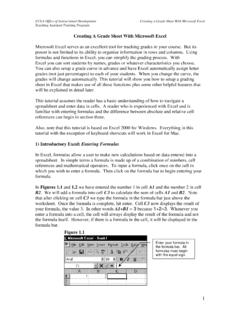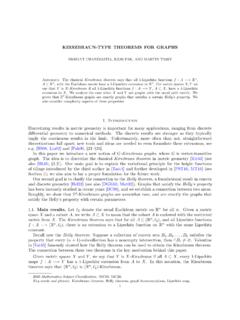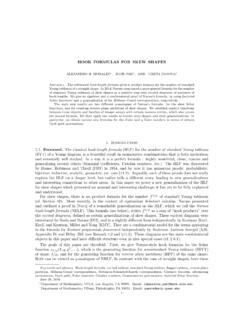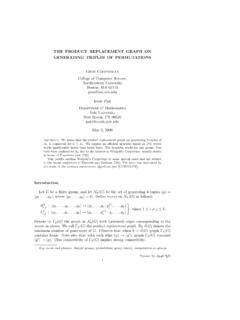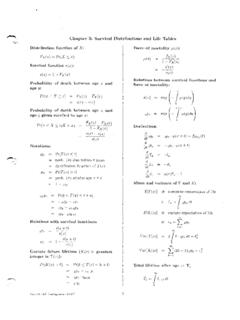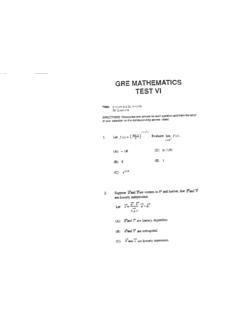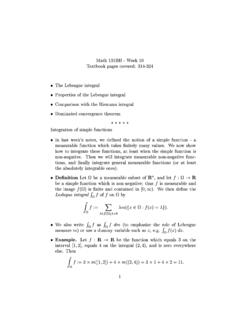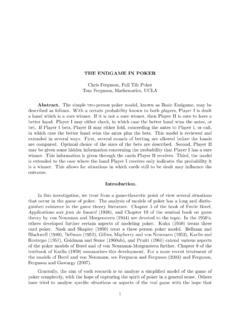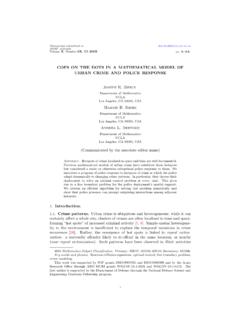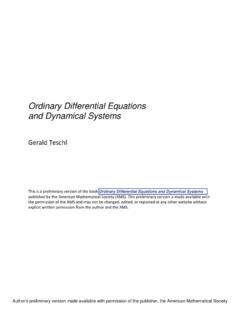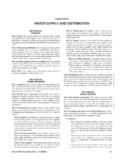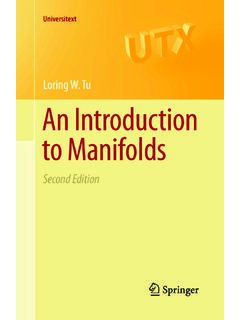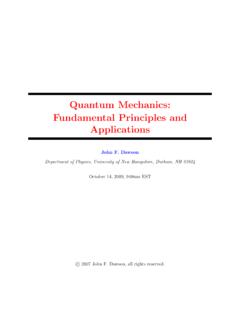Transcription of DIFFERENTIAL FORMS AND INTEGRATION - UCLA Mathematics
1 DIFFERENTIAL FORMS AND INTEGRATIONTERENCE TAOThe concept of INTEGRATION is of course fundamental in single-variable , there arethreeconcepts of INTEGRATION which appear in the subject: theindefinite integral f(also known as theanti-derivative), theunsigned definiteintegral [a,b]f(x)dx(which one would use to find area under a curve, or the massof a one-dimensional object of varying density), and thesigned definite integral baf(x)dx(which one would use for instance to compute the work required to movea particle fromatob).
2 For simplicity we shall restrict attention here to functionsf:R Rwhich are continuous on the entire real line (and similarly, when wecome to DIFFERENTIAL FORMS , we shall only discuss FORMS which are continuous on theentire domain). We shall also informally use terminology such as infinitesimal inorder to avoid having to discuss the (routine) epsilon-delta analytical issues thatone must resolve in order to make these INTEGRATION concepts fully three INTEGRATION concepts are of course closely related toeach other in single-variable calculus.
3 Indeed, the fundamental theorem of calculus relates the signeddefinite integral baf(x)dxto any one of the indefinite integralsF= fby theformula baf(x)dx=F(b) F(a)(1)while the signed and unsigned integral are related by the simple identity baf(x)dx= abf(x)dx= [a,b]f(x)dx(2)which is valid whenevera one moves from single-variable calculus to several-variable calculus, though,these three concepts begin to diverge significantly from each other. The indefiniteintegral generalises to the notion of asolution to a DIFFERENTIAL equation, or of anintegralof a connection, vector field, or bundle.
4 The unsigned definite integralgeneralises to theLebesgue integral, or more generally tointegration on a measurespace. Finally, the signed definite integral generalises to theintegration of FORMS ,which will be our focus here. While these three concepts still have some relationto each other, they are not as interchangeable as they are in the single-variablesetting. The INTEGRATION on FORMS concept is of fundamental importance in differ-ential topology, geometry, and physics, and also yields one of the most importantexamples ofcohomology, namelyde Rham cohomology, which (roughly speaking)
5 Measures precisely the extent to which the fundamental theoremof calculus fails inhigher dimensions and on general TAOTo motivate the concept, let us informally revisit the one of the basicapplicationsof the signed definite integral from physics, namely to compute theamount of workrequired to move a one-dimensional particle from pointato pointb, in the presenceof an external field ( one may move a charged particle in an electric field). Atthe infinitesimal level, the amount of work required to move a particlefrom a pointxi Rto a nearby pointxi+1 Ris (up to small errors) linearly proportionalto the displacement xi:=xi+1 xi, with the constant of proportionalityf(xi)depending on the initial locationxiof the particle1, thus the total work requiredhere is approximatelyf(xi) xi.
6 Note that we do not require thatxi+1be to theright ofxi, thus the displacement xi(or the infinitesimal workf(xi) xi) maywell be negative. To return to the non-infinitesimal problem of computing thework baf(x)dxrequired to move fromatob, we arbitrarily select a discrete pathx0=a, x1, x2, .. , xn=bfromatob, and approximate the work as baf(x)dx n 1 i=0f(xi) xi.(3)Again, we donotrequirexi+1to be to the right ofxi(nor do we requirebto beto the right ofa); it is quite possible for the path to backtrack repeatedly, forinstance one might havexi< xi+1> xi+2for somei.
7 However, it turns out inthe one-dimensional setting, withf:R Rassumed to be continuous, that theeffect of such backtracking eventually cancels itself out; regardless of what path wechoose, the right-hand side of (3) always converges to the left-hand side as long aswe assume that the maximum step size sup0 i n 1| xi|of the path converges tozero,andthe total length n 1i=0| xi|of the path (which controls the amount ofbacktracking involved) stays bounded. In particular, in the case whena=b, sothat all paths areclosed( ), we see that signed definite integral is zero: aaf(x)dx= 0.
8 (4)In the language of FORMS , this is asserting that any one-dimensional formf(x)dxon the real lineRis automaticallyclosed. (The fundamental theorem of calculusthen asserts that such FORMS are also automaticallyexact.) The concept of a closedform corresponds to that of aconservative forcein physics (and an exact formcorresponds to the concept of having apotential function).From this informal definition of the signed definite integral it is obvious that wehave the concatenation formula caf(x)dx= baf(x)dx+ cbf(x)dx(5)regardless of the relative position of the real numbersa, b, c.
9 In particular (settinga=cand using (4)) we conclude that baf(x)dx= abf(x) analogy with the Riemann integral, we could usef(x i) here instead off(xi), wherex iissome point intermediate betweenxiandxi+1. But as long as we assumefto be continuous, thistechnical distinction will be FORMS AND INTEGRATION3 Thus if we reverse a path fromatobto form a path frombtoa, the sign of theintegral changes. This is in contrast to theunsigned definite integral [a,b]f(x)dx,since the set [a, b] of numbers betweenaandbis exactly the same as the set ofnumbers betweenbanda.
10 Thus we see that paths are not quite the same as sets;they carry anorientationwhich can be reversed, whereas sets do we move from one dimensional INTEGRATION to higher-dimensionalintegration( from single-variable calculus to several-variable calculus). It turns out thatthere will betwodimensions which will be relevant: the dimensionnof the ambientspace2Rn, and the dimensionkof the path, oriented surface, or oriented manifoldSthat one will be integrating us begin with the casen 1 andk= 1. Here, we will be integrating over acontinuously differentiable path (ororiented rectifiable curve3) inRnstarting atsome pointa Rnand ending at pointb Rn(which may or may not be equal toa, depending on whether the path is closed or open); from a physicalpoint of view,we are still computing the work required to move fromatob, but are now movingin several dimensions instead of one.
